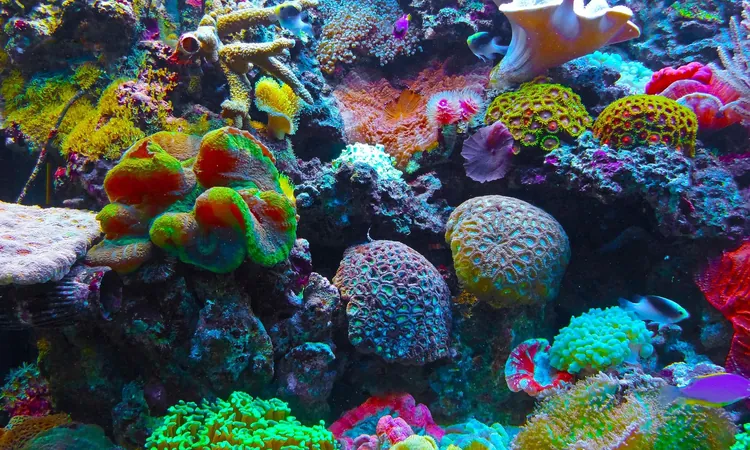
Unveiling the Deep: Rare Marine Parasite Discovered on Black Corals in Taiwan
2025-01-03
Author: Ying
Unveiling the Deep: Rare Marine Parasite Discovered on Black Corals in Taiwan
A stunning revelation has emerged from the depths of Taiwanese waters: scientists have identified a new species of parasitic crustacean, named Synagoga arabesque sp. nov., which astonishingly prefers to inhabit black corals. This discovery highlights the intricate and often elusive relationships that thrive beneath the surface of our oceans.
Found near Green Island, Taiwan, researchers detected twelve specimens of this remarkable creature in shallow waters easily accessible via scuba diving. This addition marks Synagoga arabesque as the fourth species within the Synagoga group and the second identified in the western Pacific, underscoring the vast amount of knowledge that remains to be uncovered about parasitic marine life.
A Parasite That Challenges Common Assumptions
The idea that a parasitic species could thrive on black coral might raise eyebrows, particularly because black coral is typically revered for its resilience and slow growth. The co-authors of this research pointed out that utilizing state-of-the-art imaging technologies such as scanning electron microscopy has provided unprecedented insights into this creature's delicate structure. This technique has notably offered clearer and more detailed images, revealing features that were previously indistinguishable.
Surprising Ecological Relationships
Interestingly, S. arabesque interacts with its black coral host as an external parasite, a unique characteristic within the Synagoga genus. In contrast to many of its relatives that drift freely as plankton, this species displays a distinct preference for clinging closely to its host.
Dr. Gregory A. Kolbasov, a marine biologist from Moscow State University, highlighted the importance of this find in piecing together the complex puzzle of marine ecology. The presence of such a parasite illuminates the possibility that unusual interactions in marine ecosystems are more prevalent than previously thought.
Insights from Microscopy
Morphological analyses have been crucial in distinguishing S. arabesque from its close relatives. Researchers focused on minute details such as body shape and appendage configuration, noting striking similarities with the Atlantic exemplar, S. grygieri. This resemblance suggests a possible ancient connection through a prehistoric waterway linking the Atlantic and the Indo-Pacific regions.
This connection offers a compelling narrative about how geographical shifts over millennia have influenced the distribution and evolution of marine species. The discovery of this new species not only fills a crucial gap in the taxonomy of ascothoracidan crustaceans but also sheds light on adaptive strategies employed by these unique organisms when residing on coral.
Fascinating Diversity Awaiting Discovery
The existence of both male and female specimens has further enriched research into potential differences in their morphology and behavior. Dr. Benny K. K. Chan from Academia Sinica in Taiwan remarked that the identification of species like Synagoga arabesque serves as a testament to the rich and largely uncharted diversity of marine life in the Indo-Pacific region. His insights hint at the vast array of undiscovered creatures that might be lurking amidst corals and rocks, just waiting for explorers to unveil their secrets.
The Enigma of Black Corals
Black corals, specifically Myriopathes cf. japonica, are notable hosts for these crustacean parasites. Their flexible, dark skeletons can be found in various oceanic depths, forming microhabitats that support a myriad of life forms, from fishes to other invertebrates.
The discovery of S. arabesque on black coral emphasizes the subtle dynamics and complex relationships within marine ecosystems, where slow-growing organisms engage in intricate and delicate interactions with surrounding life.
The Legacy of Ancient Oceans
Reflecting on S. arabesque unveils connections to the extensive lineage that dates back to the Tethys period, when an ancient marine corridor facilitated species distribution across vast distances. This lineage serves as a reminder of how geological and oceanic changes continue to shape marine biodiversity.
What Lies Ahead?
With only a handful of species documented within the Synagoga group, each new finding propels researchers closer to understanding how parasitic crustaceans adapt to marine environments. The documentation of S. arabesque opens the door to inquiries about countless undiscovered species that remain hidden in the Indo-Pacific and beyond.
This compelling discovery invites a reevaluation of black coral biodiversity, pushing the scientific community to delve deeper into the microscopic realms of life that cling to these mysterious corals. Continued research, particularly through advanced imaging techniques, is set to unveil even more wonders concealed beneath the ocean's surface.
The study detailing this significant find has been published in the journal ZooKeys. Stay tuned for more exciting revelations from our oceans!

 Brasil (PT)
Brasil (PT)
 Canada (EN)
Canada (EN)
 Chile (ES)
Chile (ES)
 Česko (CS)
Česko (CS)
 대한민국 (KO)
대한민국 (KO)
 España (ES)
España (ES)
 France (FR)
France (FR)
 Hong Kong (EN)
Hong Kong (EN)
 Italia (IT)
Italia (IT)
 日本 (JA)
日本 (JA)
 Magyarország (HU)
Magyarország (HU)
 Norge (NO)
Norge (NO)
 Polska (PL)
Polska (PL)
 Schweiz (DE)
Schweiz (DE)
 Singapore (EN)
Singapore (EN)
 Sverige (SV)
Sverige (SV)
 Suomi (FI)
Suomi (FI)
 Türkiye (TR)
Türkiye (TR)
 الإمارات العربية المتحدة (AR)
الإمارات العربية المتحدة (AR)